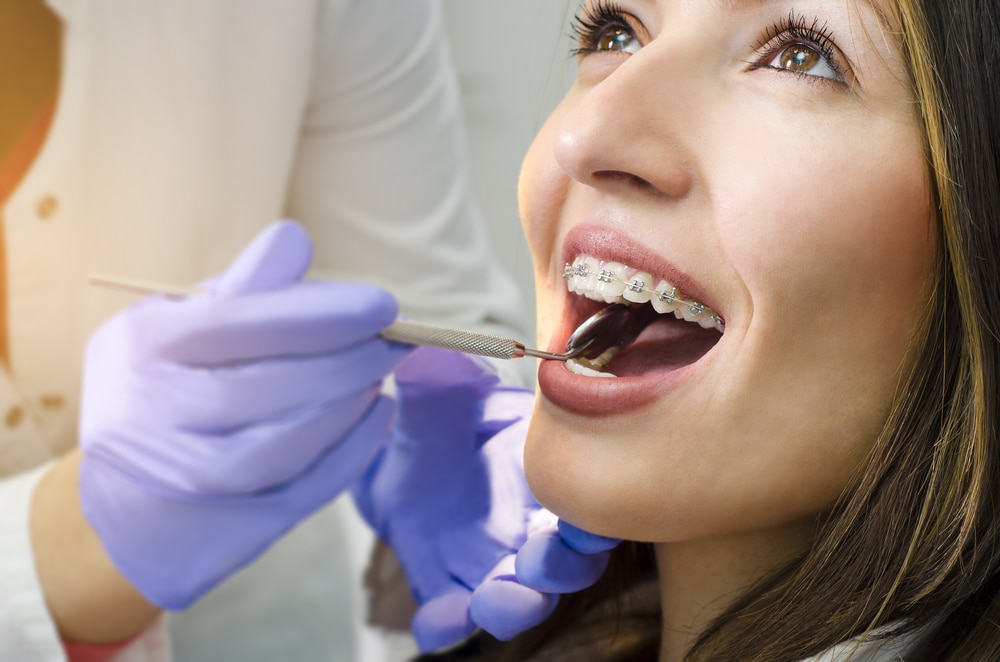
Table of Contents
Teeth Whitening With Braces
You’ve invested in your smile with orthodontic treatment and, of course, you want it to look as dazzling as possible, so you might be wondering how to whiten your teeth with braces. Before you start researching the best at-home teeth whitening kits or browsing for special toothpastes or rinses, let’s address a key question: Can you whiten teeth with braces? The answer is, yes, but you should be cautious depending on the type of braces. There is good news though. With diligent oral hygiene and some handy tools, you can keep your teeth bright and stain-free throughout your treatment, with or without whitening.
In this post, I’ll cover:
- Why whitening your teeth with traditional braces on is possible but should be done cautiously
- Whether or not you can whiten your teeth with Invisalign® or InBrace® hidden braces
- How to whiten teeth with braces
- How to keep teeth white with conventional braces and avoid braces stains
Why Whitening Your Teeth With Traditional Braces IS Possible
Conventional braces consist of brackets that are bonded to the front of your teeth and archwires that guide the teeth into place. Since the brackets are covering portions of your teeth, it’s a common myth that the bleach won’t penetrate beneath your brackets and will only whiten the visible areas. Don’t worry, when your braces come off, you won’t be left with a two-toned smile. Your teeth are made up of little tubules that connect, so even the parts under the brackets will be whitened.
However, while you can whiten teeth with braces on, even the best at-home teeth whitening kits can cause sensitivity. When you first get your braces put on and after adjustments, your teeth and gums can feel a little tender, and whitening may exacerbate this.
So, what if you have ceramic, white braces? At Jeffrey Kwong Orthodontics, our ceramic braces aren’t actually tooth-colored, white braces. They’re made from a translucent, stain-resistant material, so you don’t have to worry about your braces getting stained during treatment and no longer matching your teeth.
Regardless, whether you have conventional ceramic braces or metal braces, the biggest challenge with whitening while your braces are on is plaque control and hygiene. It’s commonly known that leaving plaque aka cavity bugs on the teeth will weaken the enamel causing white spots (technically known as decalcification, e.g., removal of the minerals). We commonly see these white spots on the teeth in between the braces and by the gum line. The concern is that we shouldn’t whiten teeth when there is an active decay process happening. Plaque control and at-home hygiene are instrumental in shaping your best smile. So, unless plaque control is as good with your braces on as it is with them off, it’s probably best to hold off and bleach your teeth afterwards.
Can You Whiten Your Teeth With Invisalign or InBrace Hidden Braces?
First, let’s talk about Invisalign. A perk of Invisalign vs. braces is that the aligners are removable. However, most of my El Dorado Hills Invisalign patients have tooth-colored Invisalign attachments bonded to their teeth. These attachments give your aligners more leverage to achieve complex tooth movements. If you have attachments, they are like conventional braces, but the best part is that more meticulous hygiene is possible with clear aligners like Invisalign. Your aligners can even serve as whitening trays; just make sure not to put lot into each tooth area because the excess will spill out and need to be wiped off with tissues to prevent sensitivity.
Can you whiten your teeth with braces that are bonded behind the teeth like InBrace invisible braces? Yes, this is a big benefit of InBrace braces! The brackets are on the tongue-side of your teeth and can’t be seen at all when you smile. So you can whiten your teeth if you have them. Even if you are left with some braces stains, they’ll be hidden behind your teeth.
How to Whiten Teeth With Braces
Now that you know whitening is possible, what are the best home teeth whitening kits for braces wearers? You can use a whitening toothpaste or a high-quality at-home kit. However, sometimes, drugstore or online whitening products can make your teeth feel sensitive. That’s why, when it comes to how to whiten teeth with braces, I recommend opting for in-office treatment or a professional take-home whitening kit from your dentist. They use a high-concentration, safe whitening formula, so you’ll get dramatically whiter teeth than you would with an over-the-counter treatment, and you’ll experience less sensitivity.
How to Whiten Teeth With Braces
If you plan on waiting to whiten your teeth after braces, it doesn’t mean you have to settle for a discolored smile. There are plenty of things you can do to keep your teeth white with braces and avoid braces stains. Here are some of my best tips for maintaining a bright smile during treatment, so you can get the best possible braces transformation:
- Brush Your Teeth in the Morning, After Meals and Snacks, and Before Bed – Brush your teeth with a soft-bristled toothbrush and fluoride toothpaste in the morning, after eating, and before bed. Brush around your brackets and every tooth surface, giving each tooth individual attention. If you have Invisalign, I’d also recommend brushing after eating and rinsing after drinking anything aside from water. This will ensure your teeth are clean when you go to put your aligners back in, and you’re not trapping food or bacteria in between your appliance and your teeth.
Frequent brushing with braces or Invisalign will help prevent surface stains, keeping teeth whiter. It will also eliminate plaque, reducing your risk of tooth decay. Teeth that are decaying definitely won’t look white!
Poor oral hygiene is also a leading cause of white spots from braces. White spots from braces are actually areas of decalcification, which are spots where the tooth has lost minerals, signaling a cavity is forming. When people do get white spots after braces, they usually show up around the brackets since this is where plaque tends to hide and release acids if not brushed away.
- Floss With Braces Once Daily – Floss your teeth once daily. This will eliminate plaque and food debris from in between your teeth and under your gum line, warding off decay and stains. While you can use regular floss for braces, a floss threader or orthodontic flosser will get the job done a whole lot faster.
- Get Into TIght Space With a Proxy Brush – A proxy brush, sometimes called an interdental brush or interproximal brush, is like a tiny, tiny toothbrush. These little brushes aren’t just great for getting in between spaced apart teeth, they’re also a key tool for cleaning the hard-to-reach areas around your brackets to keep your teeth white and kick plaque to the curb.
- Consider a Waterpik for Braces – A waterpik, or water flosser, is a favorite oral hygiene extra among our El Dorado Hills braces patients. There are special orthodontic tips for water flossers meant to clean around braces, as well as in between teeth and around the gum line. Using a waterpik for braces won’t replace regular flossing, but it is an extra step that you’ll likely find worth it. It gets rid of food particles, reaches every nook and cranny, boosts gum health, and can keep teeth looking spotless.
- Add a Mouthwash to Your Oral Hygiene Routine – If you’re prone to tooth decay, a non-whitening, fluoride mouth rinse can be super helpful. Swishing with mouthwash will zap some of the plaque and food particles that you may have missed with your toothbrush and floss. Plus, fluoride strengthens and remineralizes your enamel to reduce your risk of developing cavities and white spots on teeth after braces. There are fluoride rinses that help with whitening as well like Listerine Healthy White.
- Keep Up With Regular Dental Visits – As an orthodontist, I’m in charge of aligning your teeth and bite. Your general dentist is the dental professional who oversees your overall oral health. Keeping up with regular dental check-ups and cleanings is actually more important than ever during braces treatment.
Your dentist will ensure your teeth and gums stay healthy throughout the process, and they can help you prevent cavities or catch areas of concern in their earliest stages. If you get cavities during treatment, in severe cases, you won’t just be left with discolored teeth, you could also have to have your braces removed to have your cavities treated. This will mean more time spent in your hardware.
Aside from check-ups, professional dental cleanings are key to a brilliant smile. During professional cleanings, a dental hygienist uses special tools to remove hardened plaque (tartar) that you can’t get rid of at home with a regular toothbrush and floss. This will make teeth look whiter. They also polish the teeth, removing surface stains and smoothing the enamel, which helps stop plaque from sticking to the teeth and fights off discoloration.
- Limit Foods and Drinks that Stain Teeth – Remember when I said whitening your teeth with braces will result in a two-toned smile, because parts of your teeth are covered by your braces brackets? The same holds true when it comes to eating or drinking a lot of staining foods and beverages. If you drink tons of coffee, black tea, or red wine, or enjoy tomato sauce, berries, balsamic vinegar, and other highly-pigmented food in large quantities on a regular basis, the exposed parts of your teeth will get discolored, while the areas under the brackets will remain white, creating the appearance of white spots after braces.
While, yes, you can still drink coffee or enjoy a cup of tea with clear braces, metal braces, hidden braces, and Invisalign, don’t go overboard. Be sure to rinse your mouth out with water really well after having a mug. Try not to eat staining foods every day and when you do have them, again, rinse your mouth out or brush your teeth after.
- Enjoy Sugary, Starchy and Acidic Treats in Moderation – The bacteria in the mouth feed on sugars and starches, and release acids that eat away at the tooth enamel, causing decalcification and, eventually, cavities, both of which we’ve already established can result in tooth discoloration. Have sweets and simple starches, such as chips and white bread, in moderation. Brush your teeth or rinse your mouth out after eating them, and use your interproximal brush to get rid of any food clinging to your braces hardware. If you do have a sugary or starchy delight, eat it with a full, balanced meal, which can help neutralize the pH in your mouth.
Drinks like soda, energy drinks, and juice have a one-two punch of sugar and acidity. This combination feeds the bacteria in the mouth and erodes enamel, increasing the likelihood of tooth decay. However, anything acidic can damage enamel when you eat or drink it regularly, especially if you brush your teeth right afterwards while the enamel is in a temporarily weakened state. As the enamel wears away, the teeth will start to look yellow. Your best bet? Limit your intake of acidic foods and drinks, and wait 30 minutes to an hour after having them to brush your teeth.
- Skip the Tobacco Products – Smoking cigarettes or chewing tobacco will stain your teeth. Quitting is always a great idea for your health, but refraining while you’re in orthodontic treatment will help your teeth stay whiter with braces.
If you’re ready for your own Invisalign or braces transformation and expert advice on keeping your smile white and healthy during and after treatment, schedule a complimentary consultation at Jeffrey Kwong Orthodontics today!

